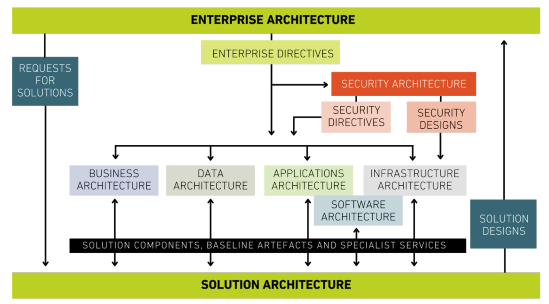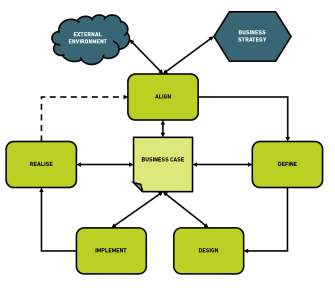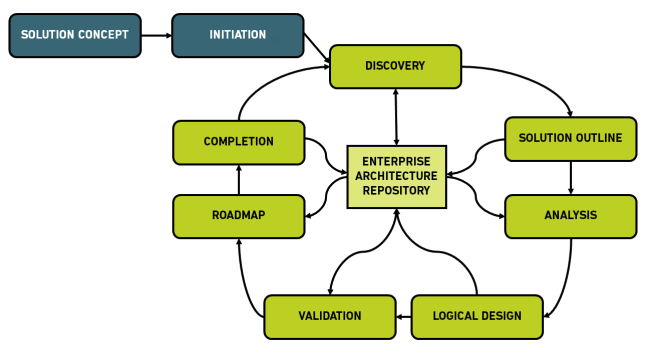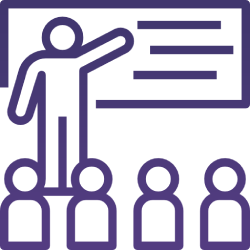BCS Membership Offer: If you do not hold a BCS certification and successfully pass the examination for this training course - you will be given one year's complementary BCS Membership. This offer is only valid for your first BCS qualification.
Our BCS Foundation Certificate In Architecture Concepts & Domains training course provides an introduction to the main aims and concepts of architecture and explores the different subdomains of enterprise architecture.
After completing our BCS Foundation Certificate In Architecture Concepts & Domains training course, you’ll understand:
Our BCS Foundation Certificate In Architecture Concepts & Domains training course will cover the following topics:
1. FUNDAMENTALS OF ARCHITECTURE
1.1 Identify the meaning and levels of architecture.
Indicative Content
a. “Fundamental concepts or properties of a system in its environment embodied in its elements, relationships, and in the principles of its design and evolution.” (ISO 42010)
b. Enterprise.
c. Domain.
d. Solution.
Guidance
Enterprise architecture encompasses the highest level of strategic change and considers all of the activity, knowledge and decision making required to support and implement this. Domain architectures are focused on more specific aspects of the enterprise, which are required to work together to achieve the aims of the enterprise. Solution architecture focuses on a specific business problem or opportunity within a specific system, which may include elements from multiple domains. It should be recognised that architecture may include elements other than IT, such as people or manual processes.
1.2 Identify the various subdomains of enterprise architecture and the interactions
between them.
Indicative Content
a. Enterprise.
• Business.
• Data.
• Applications.
• Infrastructure.
• Software.
• Security.
• Solution.
b.

Guidance
Candidates shall be aware of each of the subdomains of enterprise architecture listed and their purposes, as well as their interactions with each other as shown in the diagram.
1.3 Explain the purpose and role of standards and frameworks in architecture.
Indicative Content
a. Architecture frameworks.
b. Technical standards.
c. Professional standards.
Guidance
Various tools exist to help organisations and the architects within them to ensure their working practises are in line with industry quality standards and practises. Architecture frameworks encourage the reuse of industry and institutional knowledge and help to promote consistency across the enterprise. Technical standards help to ensure legal and industry compliance whereas professional standards promote organisational principles and drive competency and ethical practices.
1.4 Identify relevant frameworks and professional standards which apply to architecture.
Indicative Content
a. Architecture frameworks.
• DoDAF (Department of Defence Architecture Framework).
• Zachman (The Zachman Framework).
• TOGAF (The Open Group Architecture Framework).
b. Technical standards.
• ISO 42010 (Systems and software engineering – Architecture description).
• ISO 9241-11 (Ergonomics of humansystem interaction).
• ISO 27000 series (information security management systems).
• ISO 15704 (Enterprise modelling and architecture).
• ISO 14000 series (Environmental management).
c. Professional Standards.
• BCS Code of Conduct.
• DDaT (Digital, Data and Technology Professional Capability Framework).
• SFIA+ (Skills Framework for the Information Age Plus).
Guidance
Candidates can expect to be examined on their ability to identify the frameworks and standards by their name and purpose. Further information around other relevant standards and frameworks can be found in the recommended reading list.
1.5 Explain the meaning and objectives of governance, risk management and compliance.
Indicative Content
a. “Governance means controlling activity and decision making to ensure that the change delivered matches the specification agreed with the business.... through the use of processes and organisational structures”. (Solution Architecture Foundations, Mark Lovatt. BCS. 2021)
b. Risk management is “Coordinated activities to direct and control an organisation with regard to risk.” (ISO 31000)
c. “Compliance is the state of being in accordance with established guidelines or specifications”. (Alexander S Gillis, techtarget)
d. Objectives
• Minimise risk and non-compliance.
• Ensure a safe and legal approach.
• Managing stakeholder interests.
Guidance
All aspects of architecture are subject to governance to ensure that all activity and decision making reflects the enterprise needs and ways of working. Risks associated with architecture should be assessed and documented. Some level of risk may be acceptable, depending on the risk appetite of the enterprise and the cost of mitigating actions. Compliance with relevant internal and external policies and procedures including industry regulations and legislation should be monitored and standards upheld, and the impact of noncompliance should be considered during risk assessment. Each of these factors can impact stakeholder satisfaction and therefore must be appropriately documented.
1.6 Describe an architect’s contribution to a business case.
Indicative Content
a. Cost-benefit analysis.
b. ROI forecast.
c. Risk assessment.
d. Gap analysis.
Guidance
Architects of any specialism may at times contribute to the development of a business case, for the purposes of securing investment and agreeing a solution. Candidates shall be able to describe the contents of a business case as listed.
1.7 Explain the purpose and methods of performing gap analysis.
Indicative Content
a. “As is” or “baseline” state.
b. “To be” or “target” state.
c. Transitional stages.
Guidance
Gap analysis is a tool used to identify the differences between two states or solutions, represented by two architecture descriptions. By comparing the existing state and the desired state, often known as the “as is” and “to be“ states, the architect is able to identify areas for development and the scale and scope of required change. The process of transitioning to this target state may be undertaken in multiple stages, rather than all at once.
1.8 Describe a range of drivers for architecture.
Indicative Content
a. Internal and external factors.
b. Problem solving.
c. Strategic change.
d. Legal requirements.
Guidance
The need for architecture may be driven by a range of both internal and external factors such as changes to legislation, the offer of a new product or service or in response to competitor action. Candidates shall be able to describe these factors and recognise them as internal or external.
1.9 Describe the purpose and use of an architecture description.
Indicative Content
a. “Work product used to express an architecture”(ISO 42010)
b. Used to represent a state of architecture.
c. Use with views and viewpoints.
Guidance
Architecture descriptions are created to represent the architecture in a particular state and are often used in gap analysis. Two or more architecture descriptions may be used to compare an “as is” state with a possible target or transition state. A viewpoint may be applied to an architecture description, to see the architecture from a particular stakeholder view.
2. BUSINESS ARCHITECTURE
2.1 Identify the meaning and objectives of Business Architecture.
Indicative Content
a. ‘A blueprint of the enterprise that provides a common understanding of the organisation and is used to align strategic objectives and tactical demands’. (Business Architecture Guild, 2021)
b. Objectives
• Making changes to bring improvement.
• To enhance the enterprise’s capacity to enact transformational change.
Guidance
Candidates shall recognise the definition of business architecture and its objectives as listed.
2.2 Describe the key artefacts commonly used in business architecture.
Indicative Content
a. Business model.
b. Business motivation model.
c. Capability map.
d. Value stream map.
e. Functional decomposition.
f. Business process models.
Guidance
Various artefacts are associated with the business architecture domain. These are the tools, outputs and documentation related to business architecture to help model the structure of an organisation, to model processes and to plan an approach to change.
2.3 Describe the key activities undertaken by a business architect.
Indicative Content
a. Business change lifecycle.
b. Analysing a business.
c. Identifying the need for other architects and specialists.

Guidance
Business architects undertake a series of activities often by working through the Business Change Lifecycle stages listed above. A business architect is responsible for mapping the business architecture through capability-based planning and value stream mapping, as well as other tools.
2.4 Describe the structure and behaviour of a business system.
Indicative Content
a. Actors.
b. Roles.
c. Functions.
d. Processes.
e. Capabilities.
f. Services.
g. Information concepts.
Guidance
To understand a business system, architects must be able to identify and model the different processes and functions within in, as well as the input/impact on people at each stage. Candidates shall be able to describe basic components of a business system.
3. APPLICATIONS ARCHITECTURE
3.1 Identify the meaning and objectives of applications architecture.
Indicative Content
a. “Applications architecture provides a portfolio view of the enterprise’s IT applications and the application services provided by them.” (Solution Architecture Foundations, Mark Lovatt. BCS. 2021)
b. Objectives:
• Ensure the organisation has all of the applications it requires.
• Support strategic change.
• Eliminate duplication.
• Ensure consistency.
• Maximise use of resources.
Guidance
Candidates shall recognise the definition of applications architecture and its objectives as listed.
3.2 Describe the key artefacts commonly used in applications architecture.
Indicative Content
a. Applications portfolio catalogue.
b. Applications interface catalogue.
c. Applications communication diagram.
d. Use cases.
e. Functionality models.
f. Realisation diagrams.
Guidance
Various artefacts are associated with the applications architecture domain. These are the tools, outputs and documentation related to applications architecture to help understand the use, purpose and dependencies of various applications.
3.3 Describe the key activities undertaken by an applications architect.
Indicative Content
a. Ongoing reorganisation of applications.
b. Application categorisation and maintenance.
c. Monitoring and recording dependencies between applications.
Guidance
Applications architects undertake range of activities to optimise the performance of applications, such as monitoring the use of data by applications against business processes and assessing the efficiency of the interactions between applications and the user.
3.4 Describe the use and behaviour of applications in a business.
Indicative Content
a. Interactions with other applications.
b. Business users and functions.
c. Actors.
Guidance
Each application may be described by its purpose and functionality, business users, and interfaces including APIs. Dependencies between applications such as shared data and automated interfaces are also in scope for applications architecture.
3.5 Explain the purpose and use of cross-reference grids.
Indicative Content
a. Visualise relationships and dependencies with other applications.
b. Data.
c. Business function.
d. Business process.
e. Identify duplication.
f. Opportunities for reuse.
Guidance
Cross-reference grids are a tool used to visualise the dependencies and relationships of applications with other areas of architecture and how this relates to a particular function or process within the organisation.
3.6 Identify different kinds of application.
Indicative Content
a. User application.
b. Infrastructure application.
c. Platform application.
d. Business application.
e. Generic application.
Guidance
The candidate shall be able to recognise different types of application and their uses.
4. DATA ARCHITECTURE
4.1 Define the meaning and objectives of data architecture.
Indicative Content
a. “Data architecture is a subdomain of enterprise architecture and is concerned with the data, metadata and information used within the enterprise.” (Solution Architecture Foundations, Mark Lovatt. BCS. 2021)
b. Objectives:
• Meeting the data and information requirements of the business, both strategic and operational.
• Promoting understanding of data throughout the enterprise.
• Maximising the effectiveness and efficiency of data use.
• Ensuring consistency of data use and eliminating duplication.
• Complying with data legislation and regulations.
• Governing the development of new solutions.
Guidance
Candidates shall recognise the definition of data architecture and its objectives as listed.
4.2 Describe key artefacts commonly used in data architecture.
Indicative Content
a. Models and schemas of data.
b. Data definitions.
c. Data dictionaries and catalogues.
d. Data store designs for databases and data analytics.
Guidance
Various artefacts are associated with the data architecture domain. These are the tools, outputs and documentation related to the movement, storage, security and use of data within an organisation.
4.3 Describe key activities undertaken by a data architect.
Indicative Content
a. Recording and integrating data definitions and models.
b. Supporting the design of new or revised data definitions and models.
c. Auditing data designs and architecture against standards, including legislation and regulations.
d. Providing views of the data architecture to assist in solution design, data analysis and other data-related tasks.
Guidance
The scope of activities undertaken by a data architect is broad and impacts many other areas of architecture. Such activities can include providing actor or department specific views of data, auditing the use of data against relevant legislation and internal guidelines and designing data models.
4.4 Explain the differences between data and information and how they are used.
Indicative Content
a. ‘Data: reinterpretable representation of information in a formalised manner suitable for communication, interpretation, or processing.’ (ISO/IEC 2382:2015, 2015)
b. ‘Information: knowledge concerning objects, such as facts, events, things, processes, or ideas, including concepts, that within a certain context has a particular meaning.’ (ISO/IEC 2382:2015, 2015)
Guidance
Candidates shall be able to use the definitions provided to recognise and explain the difference between data and information.
4.5 Describe the data structures used by a business and/or its applications.
Indicative Content
a. Data in storage.
b. Data in motion.
c. Data structures.
d. Data items.
e. Data lifecycle. Create, store, use, archive, delete.
Guidance
As data is used throughout an organisation and throughout various applications, its state, structure and use changes. Candidates shall recognise the key terms listed and be able to describe how data moves through the data lifecycle, from creation to eventual deletion.
5. INFRASTRUCTURE ARCHITECTURE
5.1 Define the meaning and objectives of infrastructure architecture.
Indicative Content
a. “The architecture of the technology infrastructure of an organisation or enterprise that supports the delivery of business activities.”(Solution Architecture Foundations, Mark Lovatt. BCS. 2021)
b. Objectives:
• To maximise the effectiveness and efficiency of the provision and use of infrastructure including hardware, software and cloud services.
• To align infrastructure with the operational needs of the business.
• To ensure compliance with enterprise architecture principles and policy directives.
Guidance
Candidates shall recognise the definition of infrastructure architecture and its objectives as listed.
5.2 Describe key artefacts commonly used in infrastructure architecture
Indicative Content
a. Infrastructure technology catalogue.
b. Technical reference model (TRM).
c. Standards reference catalogue.
d. Hardware configuration view.
e. Application technology matrix.
f. Platform model.
Guidance
Various artefacts are associated with the infrastructure architecture domain. These are the tools, outputs and documentation related to the organisation’s infrastructure to allow architects to design, model and maintain suitable hardware and software solutions.
5.3 Describe key activities undertaken by an infrastructure architect.
Indicative Content
a. Rationalisation of components.
b. Solution technology definition.
Guidance
An infrastructure architect designs and creates a structure of hardware and software components, that will work together to address a specific business need. This solution could be on or off premises and may involve the use of cloud storage or applications, depending on the business and technical requirements identified.
6. SOFTWARE ARCHITECTURE
6.1 Define the meaning and objectives of software architecture.
Indicative Content
a. Meaning “the development and documentation of the structure and behaviour of a software system or component including its internal and external interfaces” (Solution Architecture Foundations, Mark Lovatt. BCS. 2021)
b. Objectives:
• Produce effective and efficient designs that satisfy organisational requirements.
• Ensure modularity of software that promotes interoperability and reuse.
• Ensure software service complies with service level agreements.
• Ensure software is maintainable and can be modified when business needs change.
Guidance
Candidates shall recognise the definition of software architecture and its objectives as listed.
6.2 Describe key artefacts commonly used in software architecture.
Indicative Content
a. Use case models.
b. Component models.
c. Data models.
d. Requirements documentation.
Guidance
Various artefacts are associated with the software architecture domain. These are the tools, outputs and documentation related to software architecture which help to model the intended software solution to meet the business requirements.
6.3 Describe key activities undertaken by a software architect.
Indicative Content
a. Design software structures and interfaces.
b. Problem solving and analysis.
c. Change impact analysis.
Guidance
A software architect will complete various modelling tasks and explore the needs of the end user to design a software solution to a business
problem. Where a solution is in place, a software architect can assess the impact and effectiveness of that solution and recommend change or improvement as required.
6.4 Describe system modelling techniques.
Indicative Content
a. Data flow diagrams.
b. Use case diagrams.
c. Process flow charts (activity diagrams).
d. Interaction diagrams (sequence diagrams).
e. State charts.
Guidance
Various modelling techniques may be applied in software architecture, these can be used to visualise the movement of data throughout a process or application(s), to test the response of the software under specific circumstances or to categorise the state of an object throughout a process. Candidates shall recognise these models and their uses.
6.5 Describe the role of APIs in software architecture.
Indicative Content
a. Enable data exchange and other communications between applications.
b. Enable modularisation and reuse of software components.
c. Applications communication diagram.
Guidance
An application programming interface (API) serves as means to allow the movement and exchange of data and communications between two or more applications in an organisation, or between organisations. These connections can be visualised using an applications communication diagram.
7. SECURITY ARCHITECTURE
7.1 Identify the meaning and objectives of security architecture.
Indicative Content
a. Security architecture is the embedding of security into the design and development of the enterprise.
b. Objectives:
• Minimise security vulnerabilities.
• Enforce security standards throughout the enterprise.
• Ensure all designs are robust against attack.
• Minimise the impact of security incidents.
Guidance
Candidates shall recognise the definition of security architecture and its objectives as listed.
7.2 Describe the key artefacts commonly used in security architecture.
Indicative Content
a. Security policies.
b. Threat catalogue.
c. Control catalogue.
d. Asset catalogue.
e. Risk analysis documents.
f. Data classification records.
Guidance
Various artefacts are associated with the applications architecture domain. These are the tools, outputs and documentation related to applications architecture to help understand the use, purpose and dependencies of various applications.
7.3 Describe the key activities undertaken by a security architect.
Indicative Content
a. Ongoing risk assessment.
b. Change analysis.
c. Compliance checks.
d. Testing.
Guidance
A security architect owns and undertakes a range of activities across all architecture domains. The assessment and mitigation of risk is always ongoing, and regular testing helps to ensure these measures are effective.
7.4 Identify legislation and professional standards relevant to security architecture.
Indicative Content
a. UK Data Protection Act 2018.
b. NIST (National Institute of Standards and Technology Cyber Security Framework).
c. CyBOK (Cyber Security Body of Knowledge).
d. ISO27001 (Information Security Management).
e. ISO27002 (Information Security, cyber security and privacy protection).
Guidance
Candidates shall recognise the names and descriptions of the legislation and standards listed. Additional legislation in the countries in which business activities are undertaken may also apply to security architecture, however these will not be examinable.
7.5 Identify the key concepts in data architecture security.
Indicative Content
a. Security protection.
b. Security feature.
c. Security policy.
d. Information domain.
e. Identity.
f. Encryption.
g. Checksum.
Guidance
In data security, many checks and features are in place to ensure the safe and legal use of data. These may require user input, specific storage requirements and a need to prove identity.
7.6 Identify the key concepts in applications architecture security.
Indicative Content
a. Identification.
b. Authentication.
c. Authorisation.
d. Access.
Guidance
In applications security, a four step process can be applied to correctly identify the user and provide the appropriate level of access.
7.7 Identify the key concepts in infrastructure architecture security.
Indicative Content
a. Identification.
b. Authentication.
c. Authorisation.
d. Access.
Guidance
In infrastructure security, ongoing testing and monitoring is key to ensuring that all elements are sound and to minimise vulnerabilities. Penetration testing helps to expose these vulnerabilities internally to avoid them being exploited.
8. SOLUTION ARCHITECTURE
8.1 Identify the meaning and objectives of solution architecture.
Indicative Content
a. “Solution architecture is a discipline concerned with the production and management of a blueprint for a comprehensive solution, that addresses a business need, problem or opportunity, and integrates with the business, in alignment with its strategy, while minimising negative impacts.” (Solution Architecture Foundations, Mark Lovatt. BCS. 2021)
b. Objectives:
• To create a solution which addresses a specific business problem, need or opportunity
Guidance
Candidates shall recognise the definition of solution architecture and its objectives as listed.
8.2 Describe the key artefacts commonly used in solution architecture.
Indicative Content
a. Problem statement.
b. Blueprint.
c. RACI matrix.
d. Requirements catalogue.
e. Architecture initiation document.
f. Solution outline.
g. Delivery roadmap.
Guidance
Various artefacts are associated with the solution architecture domain. These are the tools, outputs and documentation related to solution architecture which help to assess the problem and recommend a solution or range of possible solutions.
8.3 Describe the key activities undertaken by an solution architect.
Indicative Content
a. Organising the process.
b. Interacting with stakeholders.
c. Building models.
d. Analysing the problem and recommending solution options.
e. Advising the business about the solution.
f. Governing the delivery.
Guidance
A solution architect completes a range of activities beginning with understanding a problem or need, and then working with the relevant stakeholders to model and explore solutions with an aim of making a recommendation for the most suitable solution.
8.4 Describe different types of solution requirements.
Indicative Content
a. Functional or non-functional.
b. Business or technical.
Guidance
Candidates must understand that requirements are gathered to define what a solution must be able to do. These requirements are categorised as either functional or non-functional, and business or technical.
8.5 Explain the purpose and stages of the solution architecture lifecycle.
Indicative Content
a. Purpose is to provide a structured sequence for activities to be completed, to achieve a successful outcome.
b. Solution architecture lifecycle.
Guidance
Candidates should be able to recall the stages and sequence of the solution architecture framework and describe the activities undertaken at each stage.

8.6 Identify stakeholder categories in solution architecture.
Indicative Content
a. Business owners and senior managers.
b. Business sponsor or product owner.
c. End users or business actors.
d. Customers and business service users.
e. Solution architect.
Guidance
Stakeholders must be considered throughout the solution architecture lifecycle, and their needs and interests may vary throughout. Candidates shall recognise and be able to categorise stakeholders based on descriptions of their roles and interest.
Our BCS Foundation Certificate In Architecture Concepts & Domains training course is ideal for anyone involved with IT architecture, including those new to the profession.
Our BCS Foundation Certificate In Architecture Concepts & Domains training course includes full digital courseware and proctored exam voucher.
As our BCS Foundation Certificate In Architecture Concepts & Domains training course introduces you to the fundamentals of IT architecture, you don’t need any previous experience or qualifications.
The following title is required reading for anyone undertaking our BCS Foundation Certificate In Architecture Concepts & Domains training course:
Title: Solution Architecture Foundations
Author: Mark Lovatt
Publisher: BCS
Publisher Date: 2021
ISBN: 978-1-78017-5652
BCS Foundation Certificate In Architecture Concepts & Domains Examination:
Candidate Responsibilities
Create Proctor Session
Our three-day BCS Practitioner Certificate In Enterprise & Solutions Architecture V5.0 training course will help you take a practical approach to developing your competencies as an IT architect by developing and learning how to apply your knowledge and skills.
Architecture is often thought of as the building blocks of an enterprise. It is the tools, solutions and processes required to achieve an organisation’s vision in an efficient, compliant and cost-effective manner. Our BCS Foundation Certificate In Architecture Concepts & Domains training course will allow you the opportunity to learn about the basic concepts of architecture and the various domains in which an architect can operate.

All of our trainers have achieved exceptionally high delegate pass rates for accredited examinations for all our courses. We also offer complimentary pre and post-course support for any questions you may have.

We try and be as flexible as we can and accommodate your needs. We can swap delegates at any time with no charge. We can also create bespoke content should this be required.

We specialise in IT Service and Project Management. All of our Trainers and Consultants have considerable years of hands-on experience in IT Service / Project Management, working across a wide number of industry sectors.

Our training, sales and admin staff are all professional, helpful, friendly and approachable. We believe in providing excellent customer service. You will always have a dedicated friendly Account Manager
INFORMATION
There are currently no course dates that match your selected filter options. Please try another filter or contact one of our dedicated account managers on +44(0)1539 736 828 to discuss your requirements. Thanks.
Joining Instructions for Purple Griffon training courses are sent the week before the course start date. First, your Account Manager will email to confirm your booking with you. Both, the materials and exam voucher will be emailed to you the week before the training course. Finally, the tutor will send the invitation to you directly and this will be via the MS Teams or Zoom platform.
Our BCS Foundation Certificate In Architecture Concepts & Domains training course is delivered over three days.